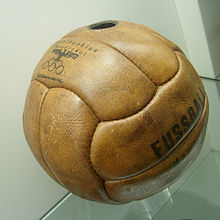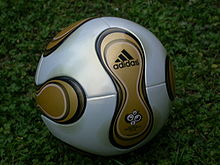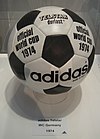Ball (association football)

In association football, the football (alternatively "football ball" or soccer ball according to whether the game is referred to as "football" or "soccer") used in official matches is a specific type of football standardised for size, weight, and material and manufactured to the specifications of the Laws of the Game, specifically Law 2.
Early footballs began as animal bladders that would easily fall apart if kicked too much. As time went on, footballs developed into what they look like today. This was possible with the help of people like Charles Goodyear and Domenico Nobili, who introduced rubber and their discoveries of vulcanization to the design of footballs. Today, technological research is ongoing to develop footballs with improved performance.
History

In 1863, the first specification for footballs were laid down by the Football Association. Previous to this, footballs were made out of inflated leather, with later leather coverings to help footballs maintain their shapes.[1] In 1872 the specifications were revised, and these rules have been left essentially unchanged as defined by the International Football Association Board. Differences in footballs created since this rule came into effect has been to do with the material used in their creation.
Footballs have gone through a dramatic change over time. During medieval times balls were normally made from an outer shell of leather filled with cork shavings.[2] Another method of creating a ball was using animal bladders for the inside of the ball making it inflatable. However, these two styles of creating footballs made it easy for the ball to puncture and were inadequate for kicking. It was not until the 19th century that footballs developed into what a football looks like today.
Vulcanization
In 1838, Charles Goodyear and Domenico Nobili introduced the use of rubber and their discoveries of vulcanization, which dramatically improved the football.[3] Vulcanization is the treatment of rubber to give it certain qualities such as strength, elasticity, and resistance to solvents. Vulcanization of rubber also helps the football resist moderate heat and cold. Vulcanization helped create inflatable bladders that pressurize the outer panel arrangement of the football. Charles Goodyear's innovation increased the bounce ability of the ball and made it easier to kick. Most of the balls of this time had tanned leather with eighteen sections stitched together. These were arranged in six panels of three strips each.[4]
Reasons for improvement
During the 1900s, footballs were made out of rubber and leather which was perfect for bouncing and kicking the ball; however, when heading the football (hitting it with the player's head) it was usually painful. This problem was most probably due to water absorption of the leather from rain, which caused a considerable increase in weight, causing head or neck injury. Another problem of early footballs was that they deteriorated quickly, as the leather used in manufacturing the footballs varied in thickness and in quality.[4]
Present developments

Elements of the football that today are tested are the deformation of the football when it is kicked or when the ball hits a surface. Two styles of footballs have been tested by the Sports Technology Research Group of Wolfson School of Mechanical and Manufacturing Engineering in Loughborough University; these two models are called the Basic FE model and the Developed FE model of the football. The basic model considered the ball as being a spherical shell with isotropic material properties. The developed model also utilized isotropic material properties but included an additional stiffer stitching seam region.
Future developments
Companies such as Mitre, Adidas, Nike and Puma are releasing footballs made out of new materials which promise more accurate flight and more power to be transferred to the football.[5]
Construction
Today’s footballs are more complex than past footballs. Most modern footballs consist of twelve regular pentagonal and twenty regular hexagonal panels positioned in a truncated icosahedron spherical geometry.[2] The inside of the football is made up of a latex bladder which enables the football to be pressurized. The ball’s panel pairs are stitched along the edge; this procedure can either be performed manually or with a machine.[3] The size of a soccer ball is roughly 22 cm (8.65 inches) in diameter for a regulation size 5 ball. Rules state that a size 5 ball must be 68 to 70 cm in circumference. Averaging that to 69 cm and then dividing by pi gives about 22 cm for a diameter.
Suppliers
Many companies throughout the world produce footballs. 75% of all footballs are made in Sialkot, Pakistan.[6] The earliest balls were made by local suppliers where the game was played. As a response to the problems with the balls in the 1962 FIFA World Cup] Adidas created the Adidas Santiago [7] - this led to Adidas winning the contract to supply the match balls for all official FIFA and UEFA matches, which they have held since the 1970s, and also supplied match balls for the 2008 Olympic Games.[8] They also supply the ball for the UEFA Champions League which is called the Adidas Finale.
FIFA World Cup
The following footballs were used in the FIFA World Cup finals tournaments:
| World Cup | Ball(s) | Image | Manufacturer | Additional information | Refs |
|---|---|---|---|---|---|
| 1930 | Two different balls were used in the final: Argentina supplied the first-half ball (the 'Tiento') and led 2–1 at the break; hosts Uruguay supplied the second-half ball (the 'T-Model' which was larger and heavier) [7] and won 4–2. | [7][9] | |||
| 1934 | Federale 102 | ECAS (Ente Centrale Approvvigionamento Sportivi), Rome | [10] | ||
| 1938 | Allen, Paris | [11] | |||
| 1950 | Duplo T | Superball | [12] | ||
| 1954 | Swiss World Champion | Kost Sport, Basel | The first 18-panel ball. | [9][13] | |
| 1958 | Top Star | Sydsvenska Läder och Remfabriken, Ängelholm (aka "Remmen" or "Sydläder") | Chosen from 102 candidates in a blind test by four FIFA officials. | [14][15] | |
| 1962 | Crack Top Star |
Senor Custodio Zamora H., San Miguel, Chile Remmen |
The Crack was the official ball. Referee Ken Aston was unimpressed with the Chilean ball provided for the opening match, and sent for a European ball, which arrived in the second half. Various matches used different balls, with the apparent rumour the European teams didn't trust the locally produced ball [7] | [7][9][14][16] | |
| 1966 | Challenge 4-star | Slazenger | 18-panel ball in orange or yellow. Selected in a blind test at the Football Association headquarters in Soho Square. | [9][17] | |
| 1970 | Telstar | 
|
Adidas | Telstar was the first 32-panel black-and-white ball used in the FIFA World Cup finals. Only 20 were supplied by adidas. A brown ball was used in some matches. | [9][18] |
| 1974 | Telstar Durlast | 
|
Adidas | [9] | |
| 1978 | Tango | 
|
Adidas | [9] | |
| 1982 | Tango España | 
|
Adidas | [9] | |
| 1986 | Azteca | 
|
Adidas | First fully synthetic FIFA World Cup ball and first hand-sewed ball | [9] |
| 1990 | Etrusco Unico | File:World Cup 1990 Football.jpg | Adidas | [9] | |
| 1994 | Questra [19] | 
|
Adidas | [9] | |
| 1998 | Tricolore | File:Adidas tricolore.jpg | Adidas | First multi-coloured ball at a World Cup finals tournament | [9] |
| 2002 | Fevernova | File:Fevernova in Berlin.jpg | Adidas | [9] | |
| 2006 | Teamgeist | 
|
Adidas | The Teamgeist is a 14 panel ball. Each match at the World Cup finals had its own individual ball, printed with the date of the match, the stadium and the team names.[8] It was replaced for the final match by the gold-coloured Teamgeist Berlin. | [9] |
| Teamgeist Berlin | 
| ||||
| 2010 | Jabulani | File:Adidas-JABULANI.jpg | Adidas | This ball has 8 panels. The ball for the final match was the gold Jo'bulani (named for Jo'burg, venue for the match. | [9][20] |
| Jo'bulani | File:Adidas Jabulani Gold (1).jpg | ||||
| 2014 | Brazuca | Adidas | This is the first FIFA World Cup ball named by the fans. | [9][21] |
European Football Championship
The following balls were used in the UEFA European Football Championship over the years:[22]
| Championship | Official football | Manufacturer | Additional information |
|---|---|---|---|
| 1968 | Telstar Elast | Adidas | This the first championship use of this ball [7] |
| 1972 | Telstar | Adidas | |
| 1976 | Telstar | Adidas | |
| 1980 | Tango Italia | Adidas | |
| 1984 | Tango Mundial | Adidas | |
| 1988 | Tango Europa | Adidas | |
| 1992 | Etrusco Unico | Adidas | This was the same ball used as in the 1990 FIFA World Cup. |
| 1996 | Questra Europa | Adidas | |
| 2000 | Terrestra Silverstream | Adidas | |
| 2004 | Roteiro | Adidas | |
| 2008 | Europass | Adidas | |
| 2012 | Tango 12 | Adidas |
Olympic Games
The following balls were used in the football tournament of the Olympic Games (note this list is incomplete):
| Olympic Games | Official football | Manufacturer | Additional information |
|---|---|---|---|
| 1996 Olympic Games | Adidas Questra Olympia [23] | Adidas | |
| 2000 Olympic Games | Adidas Gamarada [7] | Adidas | The aboriginal word for friendship, variation of the Adidas Terrestra Silverstream [7] |
| 2004 Olympic Games | Adidas Pelias | Adidas | |
| 2008 Olympic Games | Adidas Teamgeist 2 Magnus Moenia | Adidas | Variation of the Teamgeist, with Magnus Moenia meaning 'walls of the great' in Latin [24] |
| 2012 Olympic Games | Adidas The Albert | Adidas | Variant of the Adidas Tango 12 |
League balls
The following balls were used in the UEFA, AFC, CONCACAF, CONMEBOL, OFC, CAF balls over the years:
| 1. League | |
|---|---|
| Ball | League Name |
| Nike Maxim | |
| Nike Maxim | |
| Puma King Ball | |
| Adidas Torfabrik | |
| Nike Maxim CBF | |
| Nike Maxim | |
| Adidas Le 80 | |
| Adidas Tango Argentina 12 | |
| Adidas Tango 12 | |
| Adidas Tango 12 | |
| Nike Maxim | |
| Nike Maxim | |
| Nike Maxim | |
| Mitre REVOLVE FL | |
| Adidas Tango 12 | |
| Adidas Tango 12 | |
| Puma | |
| Puma | |
| Adidas Prime | |
| Nike | |
| Nike Seitiro | |
| Nike | |
| Mitre REVOLVE FL | |
| Nike Maxim | |
| Derbystar Brillant APS | |
| Grand Sport Primero Grand | |
| Động lực | |
Unicode
Unicode 5.2 introduces the glyph ⚽ (U+26BD SOCCER BALL), representable in HTML as ⚽ or ⚽.[25] The addition of this symbol follows a 2008 proposal by Karl Pentzlin.[26]
References
- ^ football World - Early History (Accessed June 9, 2006)
- ^ a b Price, D. S., Jones, R.Harland, A. R. 2006. Computational modeling of manually stitched footballs. Proceedings of the Institution of Mechanical Engineers -- Part L — Journal of Materials: Design & Applications. Vol. 220 Issue 4, p259-268.
- ^ a b Materials Science and Engineering: A Volume 420, Issues 1-2, 25 March 2006, Pages 100-108
- ^ a b Viscoelasticity of multi-layer textile reinforced polymer composites used in footballs. Journal of Materials Science. Volume 43, Number 8 / April, 2008. 2833-2843.
- ^ football World - 2000 and Beyond (Accessed June 9, 2006)
- ^ "Adidas - All posts tagged Adidas". The Wall Street Journal.
- ^ a b c d e f g h The Blizzard: Issue 6. 2012. ISBN 978-1-908940-06-3.
- ^ a b football World - Team Geist (Accessed June 9, 2006)
- ^ a b c d e f g h i j k l m n o p "The Footballs during the FIFA World Cup". Football Facts. FIFA. Retrieved 17 September 2011.
- ^ Matteo, Renato. ""Federale 102". 1934 Italia World Cup Ball" (in Spanish). balones-oficiales.com. Retrieved 17 September 2011.
- ^ ""Allen". 1938 France World Cup Ball" (in Spanish and English). balones-oficiales.com. Retrieved 17 September 2011.
{{cite web}}: CS1 maint: unrecognized language (link) - ^ ""Super Duplo T". 1950 Brazil World Cup Official Matchball" (in Spanish and English). balones-oficiales.com. Retrieved 17 September 2011.
{{cite web}}: CS1 maint: unrecognized language (link) - ^ "1954 Switzerland World Cup Official Matchball" (in Spanish and English). balones-oficiales.com. Retrieved 17 September 2011.
{{cite web}}: CS1 maint: unrecognized language (link) - ^ a b Norlin, Arne (2008). "Bollen "Made in Sweden"". 1958: När Folkhemmet Fick Fotbolls-VM (in Swedish). Malmo: Ross & Tegner. pp. 130–6. ISBN 978-91-976144-8-1.
- ^ "Top Star 1958" (in Spanish and English). balones-oficiales.com. Retrieved 17 September 2011.
{{cite web}}: CS1 maint: unrecognized language (link) - ^ Matteo, Renato (11 June 2010). ""Crack". 1962 Chile World Cup Official Matchball". balones-oficiales.com. Retrieved 17 September 2011.
- ^ Matteo, Renato (11 June 2010). ""Slazenger Challenge 4-star". 1966 England World Cup Official Matchball". balones-oficiales.com. Retrieved 17 September 2011.
- ^ Brown balls are visible in Getty Images photos of matches in the Estadio Nou Camp, [[León, Guanajuato|]]:
- ^ football World - Adidas Questra (Accessed June 9, 2006)
- ^ "The adidas JO'BULANI - Official Match Ball for the final of the 2010 FIFA World Cup in South Africa". FIFA. Retrieved 17 September 2011.
- ^ "adidas Brazuca – Name of Official Match Ball decided by Brazilian fans". FIFA. Retrieved 2012-09-03.
- ^ football World - European Football Championship balls(Accessed June 9, 2006)
- ^ "A Few Good Balls - "Adidas Gamarada 2000 Sydney Olympics"". Retrieved 13 September 2012.
- ^ "AFGB: 2008 Olympics". Retrieved 13 September 2012.
- ^ "Miscellaneous Symbols Range: 2600–26FF" (PDF). Unicode Consortium. 2009. Retrieved 2010-03-14.
- ^ Pentzlin, Karl (2 April 2008). "Proposal to encode a SOCCER BALL symbol in Unicode" (PDF). Retrieved 2010-03-14.
